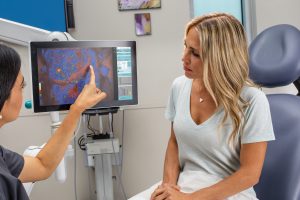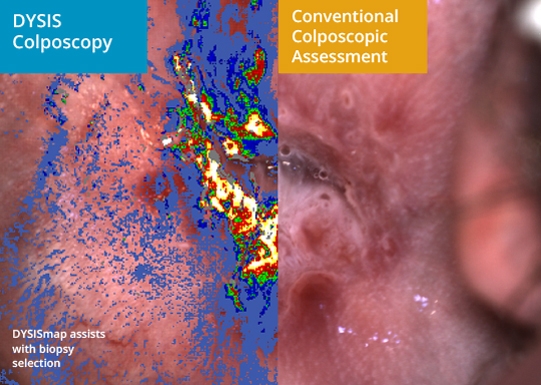What happens during a colposcopy exam?
Certain abnormal results from your Pap or HPV test may result in your provider asking you to schedule a colposcopy exam, but what is it?
Colposcopy is an examination of your cervix using a colposcope, which is a special microscope with a light.
Ask your provider if she/he uses DYSIS colposcopy. DYSIS colposcopy provides the color-coded DYSISmap that highlights the areas of the cervix with strong acetowhitening.
The purpose of a colposcopy exam is to look for cervical precancers.
What to expect during the exam
A colposcopy exam is typically conducted in your provider’s exam room and is similar to getting a Pap smear done. You lie on your back on an exam table with your feet in stirrups. Your provider will place a speculum into your vagina. The speculum holds open the walls of the vagina so your provider can see your cervix.
The provider will then use a colposcope (a special microscope with a light) to view your cervix. The provider will use a swab to clean your cervix and will then apply a vinegar (or other) solution to your cervix to help visually identify any areas of abnormal cells. The abnormal cells will appear white. In addition, your provider will also look for blood vessels and other changes on your cervix that may appear abnormal.

Biopsy during the exam
If your provider finds an area(s) that looks suspicious, she/he make take a biopsy. A biopsy is a small sample of tissue (in this case from the cervix) that is collected. To collect the sample, your provider will use a sharp biopsy tool. You may feel some mild discomfort during a biopsy like pressure and/or cramping.
Download the DYSIS patient guide to learn more about biopsy results.
After the colposcopy exam
Overall, a colposcopy exam usually lasts only 10 to 20 minutes. If you did not have a biopsy, you can usually resume normal activities. If you did have a biopsy, discuss with your provider any potential limitations or restrictions.
After the exam, you may experience some spotting or light bleeding from your vagina. If you had a biopsy, you may also experience some mild pain and a darker discharge. Use a pad to collect any blood and/or discharge.

Biopsy results
Before you leave your colposcopy exam, be sure to ask your provider when you should expect to receive the results of your biopsy. The results of the biopsy will determine if you need any further testing or treatment.
If your biopsy does find something abnormal, your provider may offer you the option of tracking and monitoring the abnormal cells to see if your body’s immune system is able to resolve the condition.
DYSIS colposcopy has SMARTtrack, which allows providers to compare images and maps from your DYSIS colposcopy exams. Ask if your provider offers DYSIS.
However, if treatment is needed, it may be as simple as an outpatient procedure. Your provider will explain your options so you can make the right decision for you.







